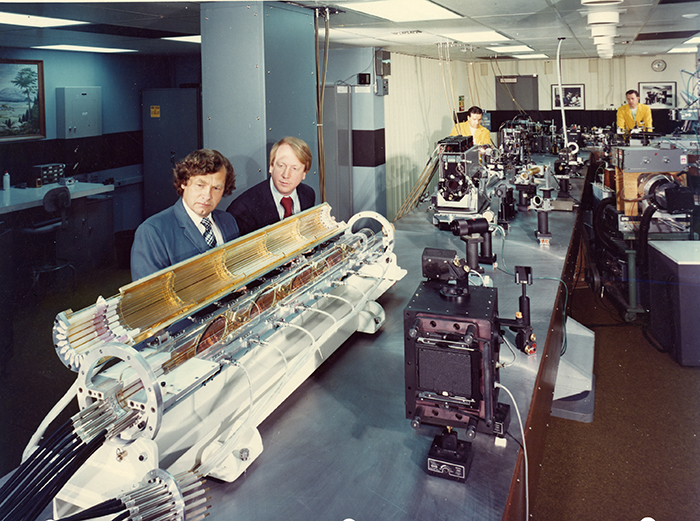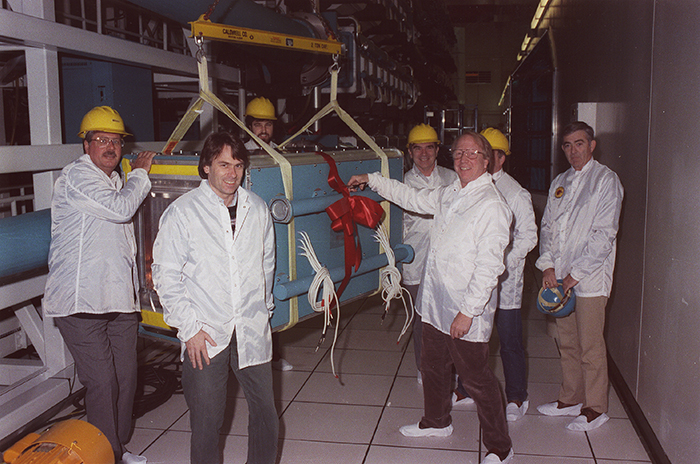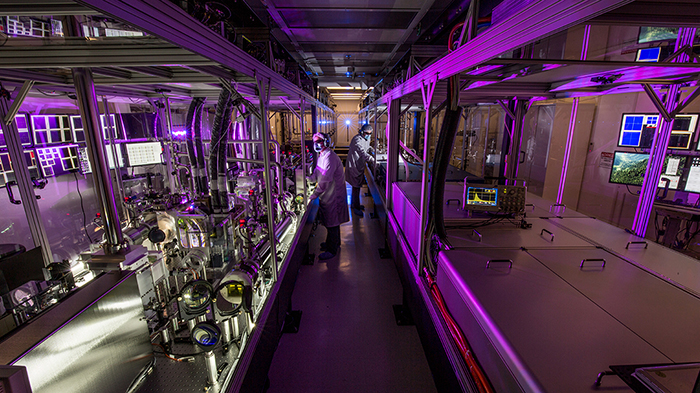NIF Celebrates 50 Years of Laser Innovation
 Carl Haussmann, left, then-LLNL associate director, and John Emmett, the first leader of the Y Division, work on lasers in this photo from 1973.
Carl Haussmann, left, then-LLNL associate director, and John Emmett, the first leader of the Y Division, work on lasers in this photo from 1973. The NIF & Photon Science Directorate celebrated last month’s 50th anniversary of LLNL’s consolidated laser program by inviting a laser pioneer to reminisce about its beginnings and two present-day experts to look toward a promising and exciting future.
Virtual sessions for LLNL employees helped mark the day, July 10, 1972, when LLNL’s experimental laser programs joined to become the Y Division. This sparked a series of increasingly complex and powerful systems that culminated in NIF, the world’s largest and most energetic laser.
John Emmett, the first division leader for Y Division and later the associate director for lasers, was the featured speaker at a July 21 session. The next day, program leaders Jean-Michel Di Nicola and Tom Spinka outlined how NIF could continue “to be next big laser in the future” even as other ultra-high-power, high-rep-rate lasers are developed.
In a wide-ranging question-and-answer session, Emmett spoke on a variety of topics, including the creation of LLNL’s first laser, Cyclops, and his thoughts on NIF reaching an energy yield of 1.35 megajoules (MJ) on Aug. 8, 2021, which put it on the threshold of ignition.
Emmett was there almost at the start of the laser itself. As an undergraduate at Caltech in the summer of 1960, he was inspired when he heard Theodore Maiman describe how he created the first working laser in May 1960.
Emmett described the technological and organizational challenges in the first two to three years of LLNL’s consolidated laser program.
“What we needed was 30 experienced people who understood the laser business,” he said. “The Department of Defense started working on lasers in 1961, and Lawrence Livermore Laboratory began working on lasers in 1970. The end result is all the expertise was in the Department of Defense.”
Another obstacle, he said, was that the Lab at the time had no way of dealing with big contracts with industrial corporations, instead relying on other parts of the Lab’s nuclear weapons complex when it needed outside capabilities.
“We needed to do big contracts with optical fabricators and glass makers and all kinds of things,” Emmett said.
 John Emmett, center, leader of LLNL’s first physics program, cuts the ribbon on the Nova laser.
John Emmett, center, leader of LLNL’s first physics program, cuts the ribbon on the Nova laser. Still, Emmett encouraged early career staff to be ambitious and not be afraid of taking “big steps” even if it brings setbacks.
“You work for the Lawrence Livermore National Laboratory,” he said. “The laboratory is for big steps, and big risks and accomplishing big things.”
Present, Future Plans for NIF
Next, Di Nicola and Spinka discussed the large single-pulse fusion driver lasers that serve the stockpile stewardship mission of the National Nuclear Security Administration (NNSA); and high-rep-rate lasers (RRL) capable of firing at up to 10 Hz (10 times per second), which can serve scientific purposes and lay the foundation for inertial fusion energy drivers.
Di Nicola, chief engineer for the NIF laser system and group leader for Laser Physics, Modelling and System Engineering Support, described small improvements in NIF that he said could lead to big impacts in performance. He also spoke about NIF’s plans to achieve 2.2 MJ of laser energy by the late spring of 2023.
“I’d like to convince you that NIF is the next big laser in the future, driven by mission needs,” he said. “NIF has definitely more headroom going all the way to 3 megajoules, which would be a 60 percent energy increase at modest power, but also 2.6 megajoules and 600 terawatts of plus-25 percent of delivered power compared to the baseline.”
He also described plans to further enhance NIF’s performance capabilities and future laser architectures that could reach 10 MJ of ultraviolet (UV) drive.
The NIF laser, Di Nicola said, is currently operating at its highest sustained levels of energy and power, and he credited continued investments by NNSA in optics and laser technology. The fidelity of the laser models, accuracy of the laser diagnostic, beam quality, front-end performance, and low-mode symmetry have all been improved.
He noted the importance of recently completing the three-year modernization of the Master Oscillator Room (MOR), the heart of the laser, to mitigate obsolescence, improve performance, and provide new capability. The new high-fidelity pulse shaping (HiFiPS) system in the MOR will enhance the shot reproducibility of high-content pulses on targets.
In addition, Di Nicola said NIF is beginning to develop next-generation concepts for the nation’s next step toward high energy yield (up to 500 MJ).
In his presentation, Spinka—program element leader for Laser Development—covered the development of high-energy, high-average, and high-peak-power lasers and how these efforts are aligned with a vision of the future.
Spinka pointed out a significant modification in the Nova laser, NIF’s predecessor, that allowed LLNL to generate petawatt (quadrillion-watt)-class peak powers for the first time. In 1996, the Nova petawatt demonstrated an at-scale implementation of chirped pulse amplification, spawning new fields of high-intensity laser-target interaction, laser physics, beams of electrons, hard x rays and gamma rays, and photofission.
Looking ahead, Spinka said high-intensity laser-target-interaction physics is rich and varied, forming the basis for many next-generation applications such as fusion energy, high energy density (HED) science and material science, medical therapy, imaging, industrial processing of components, and non-destructive evaluation.
 The L3 HAPLS laser is the world’s most advanced and highest average power diode-pumped petawatt laser system. It was designed, developed, and constructed in only three years by the NIF & Photon Science Directorate for ELI Beamlines in the Czech Republic.
The L3 HAPLS laser is the world’s most advanced and highest average power diode-pumped petawatt laser system. It was designed, developed, and constructed in only three years by the NIF & Photon Science Directorate for ELI Beamlines in the Czech Republic. Spinka also noted that NIF’s 1.35 MJ achievement created a renewed sense of excitement about the feasibility of laser-driven inertial fusion energy (IFE).
“Livermore’s laser program has this incredibly rich history of innovation and pushing boundaries of what’s possible with laser systems,” Spinka said. “Over the past 50 years, we’ve been pushing the boundaries in terms of cost per joule, total pulse, energy efficiency, average power, optics targets, optics materials, diagnostics—the list goes on and on.
“I’m really convinced that whatever the 50-year future of lasers looks like, Livermore will be central to it and I’m excited about it,” he said.
In closing, NIF & Photon Science Principal Associate Director Jeff Wisoff applauded the history of LLNL’s laser program and how that legacy set the stage for where the Lab is headed in the future.
“We’re gifted with an incredible mission to help maintain stability in the world by strengthening our nuclear deterrent and working on bringing capabilities that are needed for the future like fusion energy,” he said.
“We have the only facility that in the near term is going to get ignition using lasers,” Wisoff continued. “In a world full of balloons and dirigibles we have the Wright brothers’ plane, and I think that’s an exciting place to be. And best of all, we work with partners and colleagues that are the most talented in the world.”
More Information
“Video: 50 Years of LLNL Lasers,” NIF & Photon Science News, July 21, 2022
“Beaming with Excellence,” Science & Technology Review, April/May 2022
“A Legacy of Lasers and Laser Fusion Pioneers”
—Jon Kawamoto
Follow us on Twitter: @lasers_llnl



